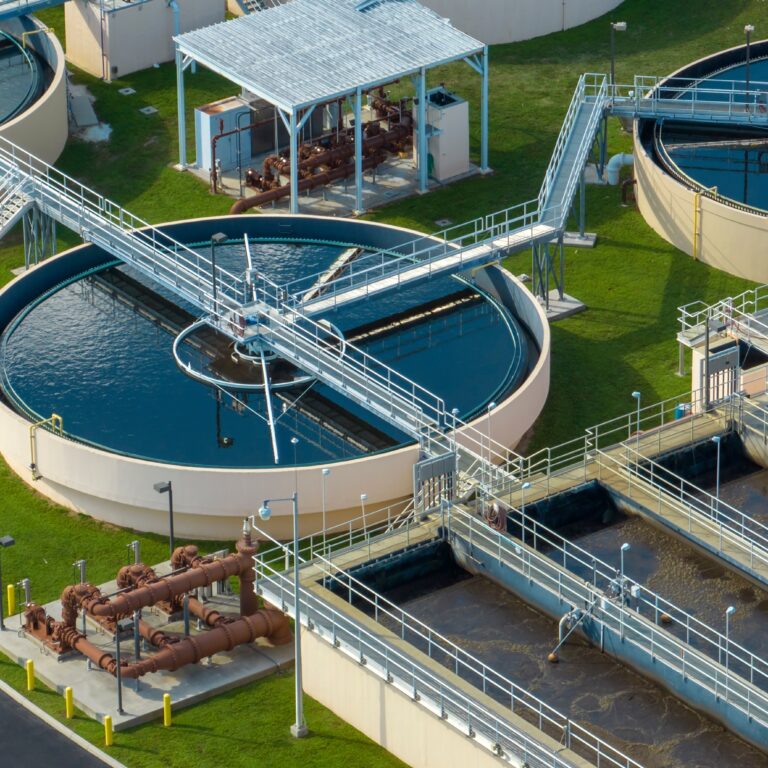Everyone knows you shouldn’t pour tap water into an espresso machine or steam iron. Why? Tap water contains minerals and molecules that cause scaling and corrosion, damaging your coffee maker. Now, imagine the impact on an extensive industrial cooling system. The whole system can fail if the water circulating through it isn’t adequately treated.
Today, almost 20% of the world’s freshwater is used for industrial applications, with over half the water used for emergency production. With freshwater becoming scarcer and environmental regulations tightening, it’s crucial to reassess industrial water treatment standards and processes for 2025 and beyond.
What Is Industrial Water Treatment?
Industrial water encompasses all water used in an industrial facility, including process water specifically used in manufacturing or production.
Industrial water treatment provides industrial processes with an adequate water supply and ensures that water has the right chemical composition for the intended use. In addition, industrial water treatment of wastewater helps reduce the discharge of harmful pollutants into the environment and comply with environmental regulations.
This treatment is crucial in sectors like power generation and chemical manufacturing to ensure efficient operations, protect equipment, and meet regulatory standards.
The process typically involves conditioning water by removing or minimizing its natural but undesirable properties. These changes can include methods for demineralizing, adjusting pH, removing hardness (softening the water), minimizing particulates, removing dissolved gases, and disinfection with UV lighting.

The methods can vary significantly depending on several factors. The first is the facility’s specific requirements or the water composition recommendations from industrial equipment manufacturers. The second is the (often inconsistent) water composition available to the industrial facility.
For example, pharmaceutical industries must adhere to regulatory requirements for the purity of water used in manufacturing processes. Meanwhile, process water in cooling tower systems and boilers must be free of contaminants and particulates to reduce equipment scaling and fouling.
Why Is Industrial Water Treatment Important For Your Business?
Adequate industrial water treatment helps enterprises lower facility maintenance costs, reduce preventable equipment malfunctions and wear, and comply with industry regulations. Some benefits of an industrial water treatment system include:
- Minimize scaling on metal components—Water impurities and residual minerals can cause scale to form on pipes and metallic equipment components. Scale can reduce equipment efficiency, accelerate corrosion, and deteriorate metal, increasing the risk of emergency water leaks and the need for expensive and frequent repairs.
- Reduce equipment fouling – Solids and certain impurities in your process water can lead to equipment fouling. When they settle, they can form a film that makes equipment less efficient in performance and potentially more prone to malfunction.
- Lower resource consumption and costs—The industrial sector’s power and water consumption significantly impacts global ecology. As a result, many companies must adhere to ESG regulations regarding water and energy efficiency. Effective industrial water treatment contributes to more efficient equipment operations, lowering a facility’s ecological footprint and utility costs.
- Ensure health and safety—Bacterial growth in process water can potentially cause bacterial proliferation, contaminating manufactured products or making employees sick. This is especially critical in facilities where adherence to Good Laboratory Practices (GLP) is mandated to ensure product safety and compliance.
- Increase operational efficiency and meet sustainability KPIs – Machines run more efficiently, need less maintenance, and have fewer breakdowns. Lower utility bills and fewer risks of regulatory non-compliance fines also make your industrial facility more efficient and profitable.
8 Key Methods of Industrial Water Treatment To Note
The industrial water treatment process starts by comparing the composition of the water supply against the optimal process water composition. Only then can you define the necessary treatment methods. Some popular ones include:
1. Screening
The first and most basic method of industrial water treatment is the coarse filtration of large particles using screens or meshes. Screening reduces sediment, organic material, and turbidity levels in the water, preparing it for the next steps in the process.
This process is commonly used in pre-treatment stages to remove large debris, such as leaves or sticks, that could clog or damage downstream equipment. By protecting pumps, filters, and other treatment systems, screening ensures smoother operation and improves the efficiency of subsequent water treatment processes.

2. Sedimentation and Gravity Separation
Gravity and centrifugal forces separate suspended solids from water, primarily targeting heavier particles. These particles settle at the bottom of a sedimentation tank, making them easier to remove before further treatment.
Sedimentation tanks are widely used in wastewater treatment plants to remove larger suspended solids before fine filtration, reducing the load on subsequent processes. This step is critical for improving the efficiency and cost-effectiveness of the overall water treatment process. Sedimentation is also commonly used in industries like food processing and mining, where large volumes of water require adequate treatment.
3. Chemical Treatment
The industrial water treatment process involves removing unwanted components from process water and adding various chemicals. Among these are flocculants (which group particles together before filtration), coagulants, and disinfectants (used to remove harmful microorganisms before further processing).
4. Thermal Processes
Thermal processes, such as heating and cooling water, isolate salt crystals (desalination) and other minerals from water. These methods are particularly beneficial in industries that use groundwater or seawater for manufacturing or equipment cooling processes.
Thermal desalination techniques, such as multi-stage flash distillation (MSF) and multi-effect distillation (MED), are commonly used for seawater desalination. MSF involves heating seawater, causing it to evaporate in multiple stages under reduced pressure, while MED uses a series of evaporators operating at progressively lower pressures and temperatures.
These processes remove salts and minerals and significantly reduce bacterial and microbial growth in process water, making it safer and more suitable for industrial use.
5. Biological Filtration
Not all microorganisms are harmful. In fact, some can be used to safely break down organic materials. When organic contaminants are high, adding oxygen through an activated sludge process helps promote the growth of beneficial microorganisms, speeding up the breakdown of pollutants. Alternatively, membrane bioreactors can combine biological treatment with membrane filtration.
Biological filtration is common in treating wastewater in the food, beverage, and manufacturing industries. This method helps reduce environmental impact and ensures compliance with local wastewater treatment regulations.

6. Nanofiltration and Electrodialysis
Nanofiltration and electrodialysis are advanced filtration methods that remove impurities from water. Nanofiltration uses a semi-permeable membrane to filter out divalent ions (like calcium and magnesium), organic compounds, and some bacteria, helping to reduce water hardness while preserving essential minerals.
Electrodialysis uses an electric field to move charged particles through membranes, effectively removing salts and dissolved contaminants. It’s beneficial for desalting brackish water and recovering valuable minerals from wastewater.
7. Reverse Osmosis (RO)
Reverse osmosis is a powerful filtration method for removing dissolved minerals, organic materials, and other impurities from water. It pumps water through a semi-permeable membrane at high pressure, allowing only water molecules to pass through while blocking larger particles, including solids, bacteria, and salts.
This method is especially effective for producing high-purity water, making it ideal for pharmaceuticals, food and beverage, and electronics manufacturing industries, where water quality is critical. However, it is not inherently energy-efficient and generates a lot of wastewater.
8. Ion Exchange
Ion exchange is another advanced process for removing harmful ions (like magnesium or calcium) from the water. The process, commonly used for water softening and deionization, uses ion exchange resins to swap out undesired ions for more beneficial ones. This process aims to reduce the concentration of materials that cause scaling and corrosion in industrial equipment.

Beyond The Tank: Industrial Water Treatment Management
Industrial water treatment systems are not cheap, so every drop of water that flows through them is valuable and should be treated accordingly. Today, data analytics and AI technologies are revolutionizing industrial water treatment systems by allowing real-time monitoring and optimization. Long are the days when technicians would regularly sample the water streams for purity to adjust the treatment processes. Instead, the adjustments are performed automatically in real-time.
Moreover, with solutions like Wint Water Intelligence, which offers predictive analytics, flow monitoring, and leak detection, you can rest assured that your industrial water treatment processes are continuously optimized for reduced operational costs and enhanced effectiveness.
As you choose the right combination of technologies and components for your industrial water treatment setup, remember that every drop counts. The best way to ensure that water is used effectively and efficiently is with a comprehensive system like Wint. Contact our experts today to learn more about how effective and efficient your industrial facility’s water systems can be.



